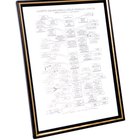Trace the history of your family and discover the roots of your family tree as you research ancestry in Singapore. Researching your ancestry offers many benefits as you link to the past through history, culture and lifestyle. Discover hardships your family has overcome and establish links with historical figures. With a few simple tools and resources, you will be well on your way to finding your ancestry in Singapore.
Record a time line and basic family tree, filling in as many lines and spaces as possible. Look through old family diaries and record any names mentioned in family records that might be linked to an ancestor.
Consult close family members to find out what information they know or have regarding your ancestors in Singapore. Ask them to fill in as many missing blanks as possible in the family tree.
Pinpoint the location where your ancestors most likely lived in Singapore based on the research you have done. Take a trip to this location and ask the local residents what they know about the individuals you are trying to trace.
Check websites that specialize in offering family searches. Many websites offer forums and pages where you may post a query regarding your ancestors so others can respond and offer information they know about your ancestry.
Use an online social networking site as a conduit for family connection and research. Invite family members you know to join you in a specific family group that you create on a social networking site.
Create a question and answer section on the family site, and then ask other family members to post stories and pictures about the family history. Ask them specifically about the ancestry in Singapore.
Utilize history forums and family forums that highlight family connections in Singapore, such as the one at Ancestry.com. Request information from forum members regarding your family ancestry in Singapore.
Spend some time in libraries and government offices in Singapore poring through archived newspapers; certificates of birth, marriage and death; records on microfiche and microfilm; and local history books. This might lead you to branches of your family tree that you never knew existed.
Related Articles

How to Trace the History of a Name

How to Trace Your Family Tree for Free

How to Find Lost Relatives

How to Find Out Where Your Family Came ...

How to Find Your Bloodline

How to Find Someone's Birth City & ...

How to Find Out If a Family Member Has ...

How to Find Wedding Announcements in ...

How to Find Recorded Family Trusts ...

How to Tell If You Have Italian Ancestry

How to Map German Surnames

How to Find Siblings Using the Birth ...

How to Find Deceased Classmates

How to Search for Japanese Ancestors ...

How to Download Free Genealogy ...

How to Search for Relatives in Other ...

How to Find Out If Your Grandmother Was ...

How to Report Verbal Abuse Against a ...

How to Find School Records for Family ...

How to Find a House Address
References
Resources
Writer Bio
Antonette Ellertson, a freelance writer from Western New York, has a Bachelor of Science degree in elementary education. She has worked as a freelance writer for more than a decade, specializing in media. She is a contributor to numerous magazines including "Maitland Primrose," "Highlights for Children" and "The Writer" and is managing editor for a large, non-profit organization.